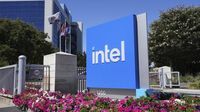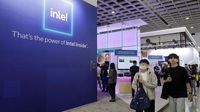On August 18, 2025, a seismic shift rippled through the global technology and finance sectors as Japan’s SoftBank Group announced a $2 billion investment in Intel, the iconic American semiconductor company. The move, which sees SoftBank purchase common stock at $23 per share—almost a 2% stake—catapults the Japanese conglomerate into Intel’s top 10 shareholders, landing at number six. But beyond the headline numbers, the deal signals a much deeper play: a strategic alignment with U.S. industrial policy, a bet on the future of artificial intelligence, and a maneuver in the high-stakes geopolitical chess game between the United States and China.
SoftBank’s investment arrives at a time when the semiconductor industry is under intense scrutiny and pressure. According to AP, shares in both companies reacted sharply to the news. SoftBank’s stock fell between 2.2% and 4% in Tokyo trading the day after the announcement, while Intel’s shares dropped 3.7% in New York on August 18, 2025. Yet, in pre-market trading the following morning, Intel shares rebounded by 5.4%—a testament to the market’s mixed, but ultimately hopeful, view of the deal’s long-term implications.
The timing of SoftBank’s move is no coincidence. As reported by Fortune and other sources, the announcement coincided with unconfirmed reports that President Donald Trump’s administration is actively considering a U.S. government stake in Intel—potentially as high as 10%—as part of a broader effort to secure the domestic semiconductor supply chain. The rumored government stake would likely come through converting CHIPS Act grants into equity, further blurring the line between public and private capital in this critical sector.
For SoftBank, led by the ever-ambitious Masayoshi Son, this is far from a casual investment. "Semiconductors are the foundation of every industry," Son stated, emphasizing that the move "reflects our belief that advanced semiconductor manufacturing and supply will further expand in the United States, with Intel playing a critical role." The company has been on a chip acquisition spree for years, snapping up Arm Holdings in 2016, Graphcore in 2024, and Ampere—founded by former Intel president Renée James—in March 2025. According to Fortune, SoftBank’s stock price more than doubled in the two months leading up to the Intel announcement, trading at a record 16,115 Japanese yen (about $109) on August 19, 2025.
This latest investment is not SoftBank’s only major U.S. tech play. Earlier in 2025, Son joined Trump, Sam Altman of OpenAI, and Larry Ellison of Oracle to announce a jaw-dropping $500 billion commitment to the Stargate artificial intelligence project. SoftBank’s role in Stargate, which seeks to build the world’s most advanced AI datacenter infrastructure, cements its position at the very center of the unfolding AI revolution. The Intel stake, therefore, is a natural extension of SoftBank’s strategy to control key layers of the AI technology stack—from chip design to supercomputing.
But why Intel, and why now? The answer lies at the intersection of geopolitical necessity and industrial ambition. With the U.S.-China tech rivalry intensifying, semiconductors have become a strategic asset. The United States, eager to reduce reliance on foreign manufacturing hubs like Taiwan’s TSMC and South Korea’s Samsung, has poured billions into domestic chipmaking through the CHIPS and Science Act of 2022. Intel, as the only major U.S. firm capable of producing advanced chips on home soil, is a linchpin in this effort. SoftBank’s investment, as highlighted by AINVEST, aligns perfectly with this national priority, giving the company a front-row seat in the U.S. semiconductor renaissance.
Yet, Intel’s position is far from unassailable. The company reported a staggering $2.9 billion loss in the last quarter before the deal, and in 2024, it recorded its first annual loss since 1986. Fierce competition from Nvidia and AMD has forced Intel to shed thousands of workers and embark on aggressive cost-cutting. Under the stewardship of new CEO Lip-Bu Tan, who took the helm in March 2025, Intel is slashing its core workforce by 15%—from 99,500 at the end of 2024 to an expected 75,000 by year’s end. Tan’s leadership has not been without controversy; President Trump initially called for his resignation but changed course after a personal meeting, later describing Tan as having an “amazing story.”
Despite these challenges, Intel’s future is tightly bound to the U.S. government’s industrial ambitions. The company has already secured $8.5 billion in federal funding for its Ohio and Arizona factories, which are critical to producing next-generation chips for AI and data centers. SoftBank’s $2 billion infusion provides additional capital to scale these efforts and potentially attract fabless clients—firms like AMD and Nvidia, which currently rely heavily on TSMC for manufacturing.
The regulatory environment is another key piece of the puzzle. The Committee on Foreign Investment in the United States (CFIUS) has ramped up scrutiny of foreign investments in critical infrastructure, particularly in semiconductors. SoftBank’s acquisition of U.S.-based Ampere Computing is currently under review, and the company must navigate a thicket of export controls and national security concerns. The December 2024 update to the Foreign Direct Product Rule, for example, restricts the flow of advanced semiconductor equipment to “countries of concern,” complicating cross-border tech deals.
For SoftBank, the risks are real but so are the rewards. The company’s deepening involvement in U.S. semiconductor manufacturing is underpinned by three pillars: the tailwind of U.S. industrial policy, strategic synergy between its AI ecosystem and Intel’s manufacturing prowess, and the long-term growth potential of AI-driven demand for advanced chips. As AINVEST notes, "SoftBank’s $2 billion investment in Intel is more than a financial transaction—it is a strategic inflection point in the global semiconductor race."
Still, the road ahead is fraught with uncertainty. Intel’s recent operational setbacks and the looming possibility of a large U.S. government equity stake could dilute corporate autonomy. Meanwhile, TSMC’s dominance in the foundry market remains a formidable obstacle. But if Intel can leverage SoftBank’s support to accelerate its foundry ambitions and recapture lost ground in the AI era, the partnership could reshape the semiconductor landscape for years to come.
For now, SoftBank’s bold bet on Intel stands as a testament to the high-stakes, high-reward nature of modern tech investing—where geopolitics, industrial policy, and technological innovation are more intertwined than ever before.







